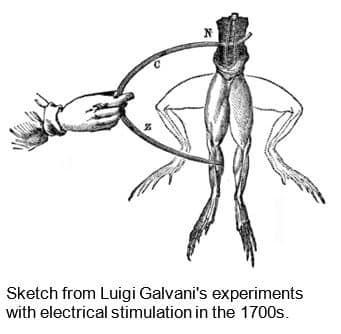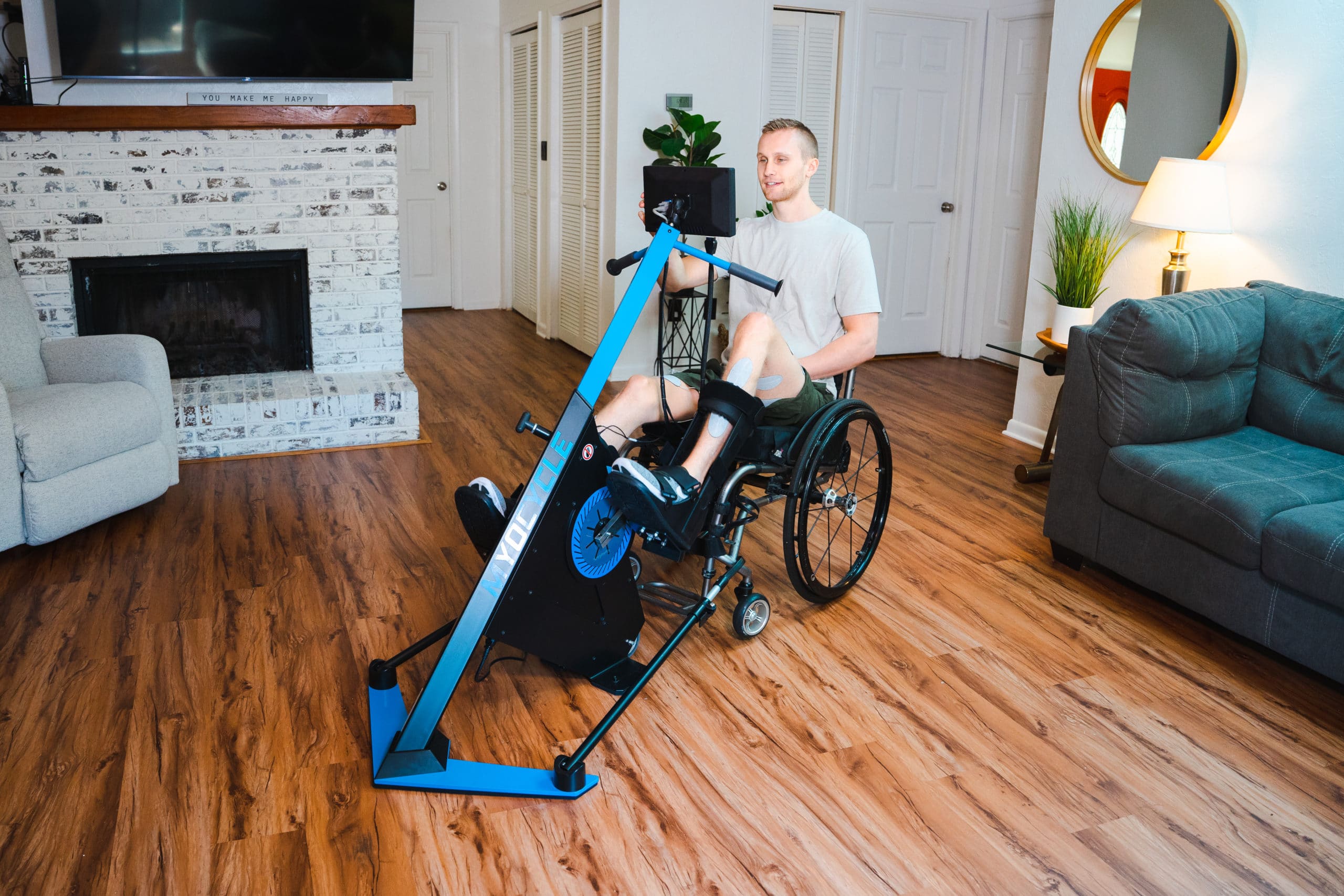Understanding the Many Types of Electrical Stimulation: A Guide to TENS, NMES, FES, and More
February 6, 2025
Electrical stimulation is a fascinating technology with the potential to dramatically change how we restore and enhance the human body. Despite centuries of research, its practical applications have not yet reached their full potential, partly due to a lack of consensus on terminology. This has led to what some call the “name game,” with many different terms and acronyms used to describe types of electrical stimulation and similar technologies.
What is Electrical Stimulation?
Electrical stimulation involves applying electricity to the body to increase or decrease activity in the nervous system. The various names for electrical stimulation arise from the different ways the current is applied, the different parts of the body targeted, and the various reasons for using the therapy.
Learn More About the MyoCycle and How to Obtain One
How Many Types of Electrical Stimulation Are There?
Electrical stimulation research will lead you to discover a lot of names, abbreviations, and acronyms, including:
- Transcutaneous Electrical Nerve Stimulation (TENS)
- Neuromuscular Electrical Stimulation (NMES)
- Electrical Muscle Stimulation (EMS)
- Functional Electrical Stimulation (FES)
- Interferential Current (IFC) Therapy
- High-voltage pulsed Current (HVPC)
- Galvanic Stimulation (GS)
- Faradic Stimulation
- Russian Stimulation or Kots Current (Burst Mode Alternating Current, BMAC)
- Spinal Cord Stimulation (SCS)
- Deep Brain Stimulation (DBS)
- Vagus Nerve Stimulation (VNS)
- Sacral Nerve Stimulation (SNS)
- and many more…
All of these names refer to the same basic thing. Namely, applying electricity to the body to increase or decrease activity in the nervous system. The different names come from applying the current in different ways, to different parts of the body, or for different reasons. Generally speaking, the different names reflect either the intended use of the electrical stimulation or the characteristics of the stimulation itself.

For example, EMS and Russian electrical stimulation are both generally intended for athletic training, but Russian stimulation uses high-frequency sinusoidal waveforms, whereas EMS typically uses lower-frequency rectangular waveforms. As another example, TENS units are typically used for pain relief, while NMES units are used to retrain muscles after an injury, even though both TENS and NMES use similar stimulation waveforms.
Instead of trying to solve the problem of the name game, this post provides a brief explanation of the most common types of electrical stimulation and how they are used in therapy and rehabilitation. Hopefully, this information will help you avoid the pitfalls of the name game and choose the right therapeutic modality for your purposes.
The Four Types of Electrical Stimulation
The four types of electrical stimulation most commonly used for therapy and rehabilitation are Transcutaneous Electrical Nerve Stimulation (TENS), Neuromuscular Electrical Stimulation (NMES), Electrical Muscle Stimulation (EMS), and Functional Electrical Stimulation (FES). Interferential current (IFC) stimulation and Russian stimulation are also commonly used.
Types of Electrical Stimulation
Let’s explore some of the most common types of electrical stimulation used today:
Transcutaneous Electrical Nerve Stimulation (TENS):
The first TENS device was developed in the 1970s by neurosurgeon Dr. C. Norman Shealy.
TENS is primarily intended for temporary pain relief in sore and aching muscles or for symptomatic relief of chronic pain. It works by altering or interrupting pain signals traveling to the brain.
It is the most pervasive type of electrical stimulation and is relatively inexpensive.
TENS is often used for conditions such as arthritis, fibromyalgia, headaches, and nerve injuries.
Interferential Current (IFC) Electrical Stimulation:
IFC was developed in the 1950s by Dr. Hans Nemec.
IFC is intended for symptomatic relief of acute, chronic, and post-traumatic or post-surgical pain. It is particularly effective for pain of musculoskeletal origin.
It is similar to TENS but is generally considered more effective and powerful.
IFC can also help to improve blood flow and circulation, reduce edema, and promote tissue repair.
Electrical Muscle Stimulation (EMS):
EMS has a long history, with its origins dating back to ancient times. The first scientific evidence of electrical current activating muscles was provided by Luigi Galvani in 1791.
EMS is intended for strengthening muscles, increasing muscle size, improving muscular endurance, and accelerating muscle recovery.
It is designed to make muscles contract strongly and is often used by athletes.
Research shows EMS can be beneficial for atrophic patients who cannot perform standard exercise.
Russian Stimulation (Kots Current or Burst Mode Alternating Current, BMAC):
Modern EMS as a localized external muscle stimulation method was significantly advanced in the 1960s by Soviet scientist Dr. Yakov Kots. He applied EMS to train elite athletes, claiming strength gains of up to 40%, and introduced it during the 1976 Montreal Olympics. Kots used alternating currents applied in high frequency bursts (BMAC) and is commonly referred to as “Russian stimulation”.
Like EMS, Russian stimulation is also intended for strengthening muscles, increasing muscle size, improving muscular endurance, and accelerating muscle recovery.
BMAC uses high-frequency sinusoidal waveforms, unlike EMS, which typically uses lower-frequency rectangular waveforms.
Neuromuscular Electrical Stimulation (NMES):
NMES is intended for relaxing muscle spasms, preventing muscle atrophy, increasing blood circulation, maintaining or increasing range of motion, and especially for re-educating the neuromuscular system.
It is essentially the same as EMS but is typically focused on therapeutic use (rehab) instead of athletic use (training).
Functional Electrical Stimulation (FES):
FES has similar uses to NMES, such as relaxing muscle spasms, preventing muscle atrophy, increasing blood circulation, maintaining or increasing range of motion, and re-educating the neuromuscular system.
FES is especially effective for neurological rehabilitation because the stimulation is automatically controlled to turn muscle contractions into functional movements.
It is often incorporated into exercise or bracing devices to maximize functionality.
What is the difference in different types of FES?
NMES vs TENS vs IFC
- TENS is mainly used for temporary pain relief and is often the most accessible and affordable option.
- IFC is also for pain relief but is generally more effective and powerful than TENS, and can also improve circulation and treat musculoskeletal pain. IFC typically uses quadripolar (four electrodes) stimulation instead of bipolar (two electrodes) stimulation like TENS.
- NMES focuses on muscle re-education and rehabilitation, helping to prevent atrophy and improve muscle strength in therapeutic settings. NMES aims to create strong muscle contractions, while TENS and IFC generally try to stimulate sensory nerves without causing muscle contractions. As a result, NMES is typically applied at higher intensities than TENS or IFC.
Russian Stim vs TENS
- Both Russian stimulation and TENS can be used to treat pain, but there are important differences. Like NMES, Russian stimulation targets muscle activation at higher intensities than TENS.
- TENS is primarily used for pain relief and uses low intensity stimulation targeting sensory nerves.
- Russian stimulation uses low-frequency bursts of current (50 Hz) with high-frequency sinusoidal oscillations (2500 Hz), while TENS uses lower-frequency waveforms (< 150 Hz).
Download the Name Game Free Ebook
Are you interested in learning more about the “name game” around the different types of electrical stimulation? Download our Free Ebook to get a better understanding of the various types of electrical stimulation and how they can be used.
Download Now!
The MyoCycle Is Your Best Choice for FES Exercise
If you’d like to know more about the applications of functional electrical stimulation (FES) or the benefits of FES cycling, check out our MyoBlog.
The MyoCycle uses FES to help people with muscle weakness or paralysis pedal a stationary bike for therapeutic exercise. Reach out to us to learn more about the MyoCycle and how you can get one for home or clinical use today!
